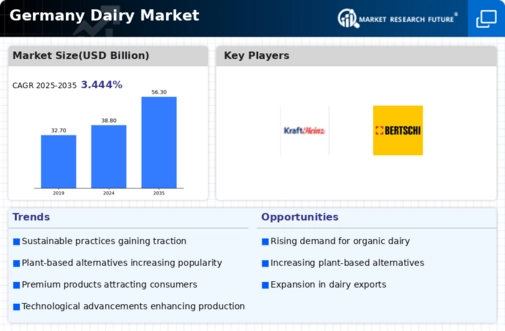Rising Popularity of Dairy Alternatives
The dairy market in Germany is witnessing a rising popularity of dairy alternatives, which is reshaping consumer choices and market dynamics. Plant-based milk and yogurt alternatives are gaining traction among consumers, particularly those seeking lactose-free or vegan options. Market analysis suggests that the dairy alternatives segment could grow by 10% annually through 2025. This trend is influenced by changing dietary preferences and an increasing awareness of environmental issues associated with traditional dairy farming. As a result, traditional dairy producers are exploring ways to diversify their product offerings to include plant-based alternatives, thereby responding to this shift in consumer demand and potentially capturing a broader market share.
Increasing Demand for Organic Dairy Products
The dairy market in Germany is experiencing a notable shift towards organic products. Consumers are increasingly prioritizing health and sustainability, leading to a surge in demand for organic dairy items. In 2025, organic dairy sales are projected to account for approximately 15% of the total dairy market revenue. This trend is driven by a growing awareness of the benefits of organic farming practices, which are perceived to be healthier and more environmentally friendly. As a result, dairy producers are adapting their offerings to include a wider range of organic options, thereby enhancing their market presence. The increasing demand for organic dairy products is likely to reshape the competitive landscape of the dairy market, compelling traditional producers to innovate and diversify their product lines.
Technological Advancements in Dairy Production
Technological innovations are playing a crucial role in transforming the dairy market in Germany. The adoption of advanced technologies such as automation, precision farming, and data analytics is enhancing productivity and efficiency in dairy production. For instance, the implementation of robotic milking systems has been shown to increase milk yield by up to 20%. Furthermore, these technologies contribute to better herd management and improved animal welfare, which are increasingly important to consumers. As the dairy market continues to evolve, the integration of technology is expected to drive growth and competitiveness, allowing producers to meet the rising demand for high-quality dairy products while maintaining sustainable practices.
Regulatory Changes Impacting Dairy Production Standards
The dairy market in Germany is currently navigating a landscape of evolving regulatory changes that impact production standards. Stricter regulations regarding animal welfare, environmental sustainability, and food safety are being implemented, which could influence operational practices within the industry. For instance, new guidelines may require dairy producers to adopt more sustainable farming practices, potentially increasing production costs. However, these regulations also present opportunities for differentiation in the market, as consumers increasingly favor brands that adhere to high ethical standards. Consequently, dairy producers are likely to invest in compliance measures and sustainable practices to align with regulatory expectations, thereby enhancing their reputation and marketability.
Shifts in Consumer Preferences Towards Functional Dairy Products
In recent years, there has been a marked shift in consumer preferences within the dairy market in Germany, with a growing inclination towards functional dairy products. These products, which include probiotic yogurts and fortified milk, are perceived to offer additional health benefits beyond basic nutrition. Market data indicates that functional dairy products are expected to grow at a CAGR of 5% through 2025. This trend is largely driven by an increasing awareness of health and wellness among consumers, who are seeking products that support their overall well-being. As a result, dairy manufacturers are investing in research and development to create innovative functional products that cater to this evolving consumer demand.













Leave a Comment